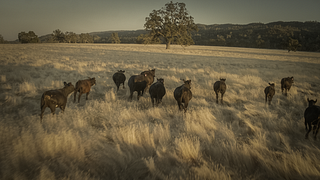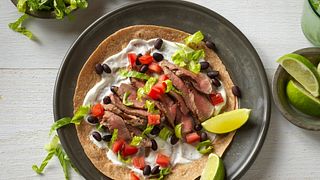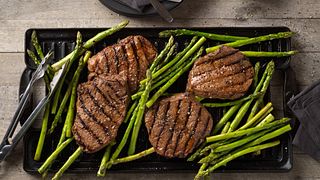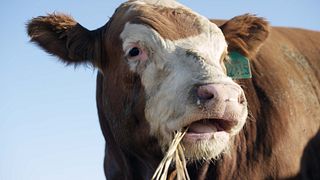frequently asked questions about beef in a healthy, sustainable diet
We all know beef tastes great – but did you know that it can be sustainable too? Check out some answers to your most pressing questions when it comes to beef’s role in a healthy, sustainable diet.
Q: Is beef sustainable?
A. Yes! And U.S. beef farmers and ranchers are leaders in sustainable beef production.1 For example, the U.S. beef industry carbon footprint is 10 to 50 times lower than other regions of the world, due to things like better cattle genetics and better animal nutrition.1
If the rest of the world were as efficient as the U.S., global beef production could double while cutting the global cattle herd by 25 percent.1 This would result in more human nourishment with less strain on natural resources and fewer environmental impacts, such as greenhouse gas emissions.
Beef farmers and ranchers will continue to work hard, as they have always done, to care for cattle, protect the land, and preserve natural resources, while raising a naturally wholesome and delicious food.
Q: Is beef healthy?
A. Yes! Beef is both nourishing and sustainable.2,3,4 Decades of research shows that beef promotes health and helps prevent human nutrient deficiencies.
The nutrients in beef promote health throughout life.5-11 Protein, iron, zinc and B-vitamins in beef help ensure young children start life strong, building healthy bodies and brains.5-8 Protein is also critical as we age. After 50 years of age, adults are at risk for losing muscle mass, leading to falls and frailty that affect their ability to age independently.9-11
It’s also important to keep in mind that plant-based protein products are often highly processed with added fat, sodium and other potentially unhealthy or unsustainable ingredients, which can reinforce unhealthy dietary patterns.12
Q: Why not choose other animal protein sources that are perceived to be more sustainable than beef?
A. No other protein source offers the same nutrient mix as beef. A 3-ounce serving of lean beef provides 10 essential nutrients in about 170 calories, including high-quality protein, zinc, iron and B vitamins.2
Environmentally, cattle do more than recycle – they upcycle inedible plants into high-quality protein.13,14 In the face of a growing global population, we need ruminant animals, like beef cattle, to help make more protein for less.13 Cattle generate more protein for the human food supply than would exist without them because their unique digestive system allows them to convert human-inedible plants into high-quality protein.14
Q: Would eating less beef be better for my health and the environment?
A. A balanced diet, which includes nutrient-rich foods from all food groups, including plant and animal foods, is important, as recommended by MyPlate and the Dietary Guidelines for Americans. Most people are already eating beef within global dietary guidelines.15 Opportunities for a healthy sustainable diet will come from reducing food waste, including beef, eating fewer empty calories and enjoying more balanced meals.
And, in fact, eating less nutrient-rich meat may put your health and the planet’s health at risk – today and in the future.15-17 Malnutrition is a significant global public health issue, and data shows that countries with the lowest meat access have some of the highest rates of malnutrition.16,17 Further, iron deficiency is a U.S. public health concern among adolescent girls and women.18,19 Unlike plant foods, beef is a source of high-quality heme iron that is more readily absorbed by the body to help your body use oxygen and support improved energy.
Environmentally, cattle do more than recycle – they upcycle inedible plants into high-quality protein. Cattle graze on land that can’t be used to grow crops, meaning they expand the land available for human food production and do it while coexisting with natural ecosystems. For example, they reduce the risk of wildfires, while providing people with high-quality protein, something plant-based proteins can’t replicate.18,19
Q. Should we shift to eating more grass-finished beef for a healthier, more sustainable diet?
A. A great thing about the beef industry is that there’s a variety of choices for consumers. There’s a cut for every budget, taste preference and recipe. Similarly, farmers and ranchers have options in raising their animals, including using resources and land sustainably based on regionality, weather and resources available.
Tradeoffs occur in different aspects of sustainability when comparing grain-finished and grass-finished beef production systems. Grain-finished beef has a lower carbon footprint than grass-finished beef due to more efficient utilization of feed in the finishing phase, meaning cattle at feedyards convert feed to muscle at a very efficient rate; it’s also due to fewer days on feed and a greater amount of beef produced per animal. Grass-finished beef has a higher carbon footprint, due to a high forage diet (e.g., grass and hay), which causes cattle to produce more methane emissions from the digestive tract than higher-energy, grain-based diets. However, grass-finished beef has some sustainability advantages, as this system contributes to sustainable beef production by sequestering carbon dioxide from the atmosphere, which can help to mitigate global climate change. Importantly, regardless of the finishing system, U.S. cattle spend most of their lives on grass and over 80% of what grain-finished cattle eat in their lifetimes is grass and other forages.
Q. Is beef a big contributor to U.S. greenhouse gas emissions?
A. No. U.S. beef’s carbon footprint is 10 to 50 times lower than other regions of the world, due to improved productivity practices and scientific advancements, from better cattle genetics to better animal nutrition.1 According to the U.S. Environmental Protection Agency, greenhouse gas emissions from beef cattle only represents 2% of emissions in U.S.20 All of agriculture, including beef production, accounts for around 9% of total U.S. emissions. By contrast, transportation accounts for 27% of emissions in the U.S., representing a far more impactful opportunity for reducing greenhouse gas emissions.21
According to research published in the Proceedings of the National Academies of Sciences, if all livestock in the U.S. were eliminated and every American followed a vegan diet, greenhouse gas emissions would only be reduced by 2.6%, or 0.36% globally. And, this would lead to an increase in use of synthetic fertilizer and increased soil erosion.4
Additionally, greenhouse gas emissions from beef production have declined over time. According to UN Food and Agriculture Organization data, greenhouse gas emissions from beef cattle declined 31% from 1975 to 2016, while beef production increased by 2%. Farmers and ranchers are committed to doing more with less and measuring their progress, while maintaining high standards of animal care.
Conclusion:
As we work together to build a healthier, more sustainable food supply for ourselves and future generations, we are able to focus on changes that are science-based, practical and highly impactful, like improving global agricultural productivity, reducing food waste, decreasing over-consumption of empty calories and consuming balanced meals.
Subscribe to our newsletter so you don't miss the best recipes, cooking tips, and more.
Privacy Policy- U.N. Food and Agriculture Organization. FAOSTAT Database – Food and agricultural data. Available at: http://www. fao.org/faostat/en/#home (accessed August 17, 2017).
- US Department of Agriculture, Agricultural Research Service, Nutrient Data Laboratory. USDA National Nutrient Database for Standard Reference, Legacy. Version Current: April 2018. Internet: /nea/bhnrc/ndl
- United States. Department of Health and Human Services., United States. Department of Agriculture., United States. Dietary Guidelines Advisory Committee. Dietary guidelines for Americans, 2015-2020. Eighth edition. ed. Washington, D.C.: U.S. Department of Health and Human Services and U.S. Department of Agriculture; 2015. https://www.cdc.gov/nchs/data/hestat/obesity_adult_07_08/obesity_adult_07_08.pdf
- White, RR, Hall MB. Nutritional and greenhouse gas impacts of removing animals from US agriculture. Proc Natl Acad Sci U S A. 2017 Nov 28;114(48):E10301-E10308.
- American Academy of Pediatrics. Pediatric Nutrition Handbook. 7th ed. Elk Grove, IL: American Academy of Pediatrics, 2014.
- Tang M, Krebs NF. High protein intake from meat as complementary food increases growth but not adiposity in breastfed infants: a randomized trial. Am J Clin Nutr2014;100:1322-8.
- Nyaradi A, et al. The role of nutrition in children’s neurocognitive development, from pregnancy through childhood. Front Hum Neurosci 2013;7:97.
- Krebs NF, et al. Effects of different complementary feeding regimens on iron status and enteric microbiota in breastfed infants. J Pediatr 2013;163:416-23.
- Wolfe, R. The underappreciated role of muscle in health and disease. Am J Clin Nutr 2006; 84:475-82
- Layman DK, et al. Dietary protein and exercise have additive effects on body composition during weight loss in adult women. J Nutr 2005;135:1903-10.
- Symons TB, et al. Aging does not impair the anabolic response to a protein-rich meal. Am J Clin Nutr 2007;86:451-6.
- What We Eat In America, NHANES, 2003-2004 and 2015-2016. https://www.ars.usda.gov/ARSUserFiles/80400530/pdf/DBrief/20_Food_Patterns_Equivalents_0304_1516.pdf
- Council for Agricultural Science and Technology (CAST). 1999. Animal Agriculture and Global Food Supply. Task force report N. 135 July 1999, Department of Animal Science, University of California, Davis, CA, USA. Available at: http://agrienvarchive.ca/bioenergy/download/anag.pdf
- National Academies of Sciences, Engineering, and Medicine. 2016. Nutrient Requirements of Beef Cattle: Eighth Revised Edition. Washington, DC: The National Academies Press. https://doi.org/10.17226/19014
- McNeill S, Van Elswyk ME. Red meat in global nutrition. Meat Sci. 2012 Nov;92(3):166-73. doi: 10.1016/j.meatsci.2012.03.014. Epub 2012 Apr 1.
- Development Initiatives, 2018. 2018 Global Nutrition Report: Shining a light to spur action on nutrition. Bristol, UK: Development Initiatives. https://globalnutritionreport.org/reports/global-nutrition-report-2018/burden-malnutrition/
- FAO, IFAD and WFP. 2015. The State of Food Insecurity in the World 2015.Meeting the 2015 international hunger targets: taking stock of uneven progress.Rome, FAO.
- Cook JD. Adaptation in iron metabolism. The American Journal of Clinical Nutrition.1990;51(2):301-308.
- Le CHH (2016) The Prevalence of Anemia and Moderate-Severe Anemia in the US Population (NHANES 2003-2012). PLoS ONE 11(11): e0166635.
- Zanovec M, O'Neil CE, Keast DR, Fulgoni VL 3rd, Nicklas TA. Lean beef contributes significant amounts of key nutrients to the diets of US adults: National Health and Nutrition Examination Survey 1999-2004. Nutr Res. 2010 Jun;30(6):375-81.
- EPA. 2018. Inventory of U. S. Greenhouse Gas Emissions and Sinks: 1990-2016. U. S. Environmental Protection Agency, Washington, D. C







